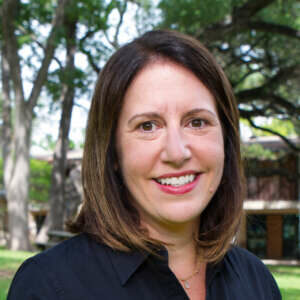By: Dr. Claire Miller Colombo
It’s Holy Week — a week when many Christians spend hours and hours in church, reliving the story at the center of our tradition. Some of us relish the liturgical intensity of the week. We revel in its solemnity, surrender to its catharsis, savor the coming of Easter.
This is not the experience of all people in the pews.
During a Holy Week liturgy a few years ago, I spotted a person who appeared physically uncomfortable. They did not join the communal prayers or sing the songs. Their body language was self-contained. Their gaze was often cast downward.
In our liturgical froth, it is easy to forget that the passion-week story is one of religious trauma. It is the story of a person betrayed by his friends and his community of faith, a person whose safety at all levels is shattered, a person whose very self is negated to the point of execution.
We might forget that for some people in the pews, reliving this story can be painful or even intolerable. It can trigger distressing memories and activate spiritual wounds.
At that Holy Week service a few years ago, I noticed the person resisting worship, and I wondered why they were in church at all. Unfortunately, I had not yet learned about trauma-informed care. If I had, I might have been sensitive to the possibility that the person had experienced religious trauma. My curiosity about their discomfort — not to mention my judgment about their seeming indifference — might have instead taken the form of compassion.
What Is Religious Trauma?
In a traumatic event, a person is “rendered helpless by overwhelming force” and cannot access sources of control, connection, and meaning (1). Trauma is best understood not as something that happened “back then,” but as “the current imprint of that pain and fear living inside people” (2). We all carry some degree of trauma in our bodies; it shapes our nervous systems and the way we move in the world (3).
Although not yet identified as a mental-health diagnosis, religious trauma is widely recognized by practitioners. It can be defined as the condition experienced by those harmed by or struggling to leave an authoritarian religion or set of beliefs (4). It might be sustained by a child feeling same-sex attraction who is accused of sinning, or by an unmarried pregnant woman shunned by her faith community. Milder forms of religious trauma may be experienced by those barred from positions of authority because of gender or shamed for some aspect of their self-experience or self-expression.
A common source of religious trauma is spiritual abuse, which occurs when a person is coerced or exploited by someone with religious authority (5). Clergy sex abuse is one type of spiritual abuse. The use of scripture to justify the control of a spouse or worker is another.
Religious trauma is difficult to define because it exists along a spectrum; not all trauma is inflicted in extreme settings. It can also be hard to pinpoint because its experience is subjective: one person’s mind and body might respond to given circumstances differently than another’s.
What is experienced as a source of connection and life by you might be experienced as a source of agony or diminishment by another.
“Spiritual trauma looks different in everyone,” one spiritual director and abuse survivor writes. “Words, symbols, rituals, smells, scents, sounds, spiritual authority figures, [and the idea of] God can trigger buried memories” (6).
For this reason, it is important for those of us who identify as Christians to recognize when someone might be experiencing religious trauma — especially in a context we consider holy.
Indicators of Trauma
Immediate symptoms of trauma can take the form of hyper-arousal — the “fight, flight, or freeze” response indicated by a racing heart, sweating, shallow breathing, and unwelcome images or flashbacks. Trauma can also manifest as hypo-arousal — dissociation or surrender that might look like spacey or “checked-out” behavior, slackened muscles, or time confusion (7).
Longer-term symptoms can include depression, anxiety, a fractured sense of self, and an aversion to triggering contexts.
When I recall the person in the pew at the Holy Week liturgy, I wonder whether they had been triggered by the story. I wonder whether they felt “frozen” or wanted to “flee.” (The structure of a liturgy can make us feel held in place.) I wonder whether their mind had “checked out” as a way of self-protecting.
Healing Religious Trauma
Because trauma obliterates a sense of safety, erodes autonomy, and disconnects a person from others, healing involves the recovery of these very things. Safety must be re-established; the trauma story must be owned and retold; and a connection with community must be rebuilt (8).
This work is best done in a therapeutic context. Trauma-informed therapists use tested methods to create safety, heal the body-mind connection, and rebuild connections. Faith leaders must be able to identify the signs of trauma and refer those in crisis to an appropriate professional. (This will not be an “if” scenario in ministry; it will be a “when.”)
Alongside therapy, other resources can help heal religious trauma. One of the most powerful of these is trauma-informed spiritual care. Spiritual directors, in particular, are trained to meet people where they are — which often means showing up for those who cannot tolerate sitting in the pews.
During the reestablishment of safety, trauma-informed spiritual directors can offer a “safe sanctuary of Presence” (9). They can help a person access joy, connect with their bodies, and express difficult emotions (using, for example, the psalms of lament).
During the owning and retelling of one’s story, spiritual directors can offer deep listening within a judgment-free space. They can help a person feel seen and worthy. They can also support the use of spiritual practices as a return to safety when needed.
During the work of reconnection with community, spiritual directors can help a person situate their experience within a larger, life-giving story. They can present the divine as an abiding presence — a “with you” energy rather than an “against you” force. Safety with a spiritual director can also help heal wounds of abuse by a spiritual authority.
Although a person might never return to the community where their trauma occurred, mental and spiritual healthcare can help a person live into a new kind of spiritual flourishing.
Easter in the Pews
For every person in distress in a pew, there are countless traumatized others who do not attend church at all. Trauma has been called most urgent public health issue of our time, and I wonder whether declining church attendance might be an expression of this cultural crisis. People may stay away from church not because it bores them or doesn’t “speak their language,” but because for them it is a place of pain, a place where their very selves are, to some degree, executed.
During Holy Week, some of us may experience the power of place positively. We may find healing and connection in our embodied worship. Others may experience the power of place negatively. We may feel triggered by, or resistant to, the narrative of religious trauma being rehearsed.
May all of us drawn to the liturgies of Holy Week be agents of Easter as we grow in sensitivity to those in the pews — and to those far away from them — who have been hurt by the churches we sit in.
Questions for further reflection:
How might awareness of religious trauma change the way I engage others?
Do I carry any religious experiences that might be explored with a spiritual director?
As a trauma-informed caregiver, what resources can I have at hand to support the people I serve?
Footnotes:
(1) Judith L. Herman, M.D., Trauma and Recovery: The Aftermath of Violence — From Domestic Abuse to Political Terror (New York: Basic Books, 1992), p. 48.
(2) Psychotherapy Networker. YouTube. “Bessel van der Kolk Explains What Trauma Is.” Retrieved April 2, 2023, from https://www.youtube.com/watch?v=6vwNX0Qo1IA.
(3) Resmaa Menakem, My Grandmother’s Hands: Racialized Trauma and the Pathway to Mending Our Hearts and Bodies (Las Vegas: Central Recovery Press, 2017), p. 7. See also https://www.resmaa.com/somatic-learnings/healing-racialized-trauma-begins-with-your-body.
(4) M. Winell, “Religious Trauma Syndrome” (2021); retrieved from Journey Free: https://journeyfree.org/rts/ on April 2, 2023.
(5) Lisa Oakley and Justin Humphreys, Escaping the Maze of Spiritual Abuse: Creating Healthy Christian Cultures (SPCK Publishing, 2021).
(6) Kathryn Walczyk, “From My Chair: An Understanding of Spiritual Abuse, Trauma, and Well-Being as a Spiritual Companion,” Presence: An International Journal of Spiritual Direction (24:1, March 2018), p. 52.
(7) Much of the information in sections 2 and 3 comes from Anne Province, MAR, “Trauma Informed Spiritual Direction,” an unpublished resource based on the work of Dr. Linda Manning, LPC. I am grateful to both spiritual teachers for their work.
(8) Herman, Trauma and Recovery, p. 4.
(9) Province/Manning, “Trauma Informed Spiritual Direction,” p. 4.




One Response
Deep thanks to Dr. Colombo for this insightful paper. I will share it with a Companion of mine who is a spiritual director. Wonderful that the Seminary has faculty who can enable the students to see this aspect of Christianity.